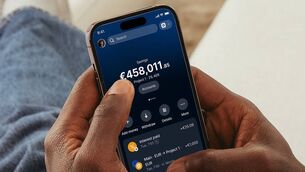Google ticks most boxes with Pixel phones

says Google’s Pixel 3 and Pixel 3 XL phones may not be perfect, but there’s plenty to love about them
Everybody has heard of Google, but most won’t be familiar with their range of Pixel phones. This is probably because until now, Google’s Pixels were not available to buy directly in Ireland.
This has changed with the release of the Pixel 3 and Pixel 3 XL. I’ve been using the latter since it launched on October 9, and although it’s not perfect, there’s much to love about this Made by Google goodness.
The Pixel 3 and Pixel 3 XL use the same hardware, but the XL version has a bigger screen and a divisive notch. There’s been so much talk about the massive notch on the Pixel 3 XL, which is used to house two front-facing cameras and a speaker, but honestly, it doesn’t bother me and it’s one of those things you just get used to.
A notch allows for additional screen space by housing all of your notification icons like battery percentage, time and so on, either side of the notch, which would otherwise be a chin.
From a practical point of view, this makes a lot of sense, but not so great for aesthetics. If you don’t like the notch, just go for the Pixel 3 or another phone that doesn’t have a notch.
This year’s Pixel now comes with wireless charging thanks to a glass back, that unlike almost all other flagship phones, doesn’t have a super glossy finish. Instead, most of the back is a sandblasted matte finish with the top portion, where you’ll find the single camera and flash, is a glossy finish. This makes the Pixel 3 feel great in the hand and a lot less slippery. I can see other phone makers adopting this finish and it’s a wonder no one else has thought of it until now.
Around the front and apart from the aforementioned notch, the Pixel 3 XL has a massive 6.3in QHD+ OLED screen. On the bottom, there’s a big chin, but this houses the second front-facing speaker, the first being the one in the notch. The Pixel 3 has a notchless 5.5in full HD+ OLED display.
Not all OLED screens are made equal and although the Pixel 3 XL screen isn’t as super bright as some, it has excellent colour saturation. It produces punchy visuals with pin-sharp resolution.
The front-facing stereo speakers are some of the loudest I’ve heard on a smartphone and although sound quality is great, it’s not amazing.
That being said, this is a fantastic device for watching videos and the front-facing speakers make a massive difference.
It’s worth noting that both Pixels are certified by the UHDA as Premium HDR and there’s a growing number of YouTube videos that can display this high dynamic range-ready content. Unfortunately, Netflix doesn’t yet support the Pixel phones in HDR, but phones like the Huawei P20, which was released back in March, only recently received support, so it takes time.
Almost all phones now, from mid-range to flagships, have at least two cameras on the back. Not so with the Pixel 3 XL. Google can do most of what all of these other manufacturers do with hardware, using just software.
Their years of machine-learning smarts and AI-powered technology allows them to use computational photography to achieve incredible results from a single sensor and lens.
The rear camera is a 12.2-megapixel, so no telephoto or ultra-wide options. The now popular bokeh effect, that blurs out the background of your subject, and implementation of HDR is simply amazing.
This works really well most of the time, but it can be fooled, as it can in all of the phones I’ve ever tested. That being said, the Pixel 3 does an incredible job of creating a stunning photo almost every time with a simple point-and-shoot philosophy.
The camera software interface is simple and clutter free. Other impressive camera features include the auto-focus tracking, that allows you to point at a moving subject and it will track and keep it in focus.
When the lights dim, the Pixel 3 still manages impressive photos and this will improve with a new Night Sight mode, which still wasn’t available during my time of testing, but is due soon in a free update.
You also get a pseudo zoom, which uses a well-established photographic technique to digitally zoom, take a bunch of shots and then take all of the information to create a single frame. This works amazingly well and certainly offers greater flexibility, but if you’re a pixel peeper, it doesn’t really match the same shot using an actual zoom lens. Video is also excellent, with recording up to 4K 30fps and solid image stabilisation. The only thing that wasn’t great in video is the sound from the internal mics.
On the front, there are two cameras; wide angle and the second extra wide, both 8MP. Both offer some of the best selfie results I’ve ever seen, but the results, as with the rear camera, can seem overprocessed when you pixel peep. That being said, at 100% when viewed on social media, they look stunning.
Overall, I’ve really enjoyed using the Pixel 3 XL. Battery performance is good but not exceptional, the hardware is adequate, sporting the latest Snapdragon 845 processor, but only 4GB of RAM and 64GB of storage with an option of 128GB, but no microSD to expand.
During my time of testing, I did have software bug issues, but these will be sorted in a software update and unlike all other Android phones, the Pixel 3 will get any new updates as they become available.
Finally, the Pixel 3 and Pixel 3 XL support wireless charging and for an extra €79 you can buy the excellent Pixel Stand for smarter, fast wireless charging.
This works great and will charge other wireless charging compatible devices too.
At €890 for the Pixel 3 XL with 64GB of storage, it looks like Google are going the way of Apple where you’re not just buying solid hardware, but they also want you to pay for the software experience too. With so many compelling flagship offerings this year, it’s down to personal choice if you want to go for the more pure and fluid Android experience you’ll get from a Pixel device.
The Pixel 3 and Pixel 3 XL is available from Vodafone starting at €780 for Pixel 3 and €890 for the Pixel 3 XL PAYG.














